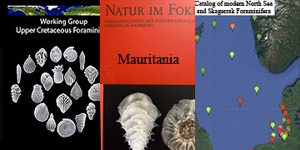What are Foraminifera
Foraminifera, in short forams, are single-celled organisms which live in the oceans. They consist of cytoplasma, which is stabilized and protected by an inner shell called test. Either they float in the water column (
planktonics) or live on the sea floor (
benthics). Of the approximately 6,000 species living today, only about 50 species are planktonic. It is estimated that there are about 42.000 species, which went extinct.
 Main
Key to Species
About
Contact
Main
Key to Species
About
Contact


